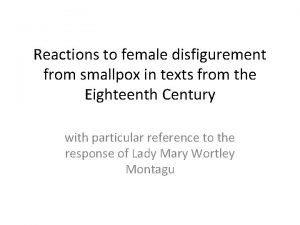Reactions to female disfigurement from smallpox in texts









- Slides: 9

Reactions to female disfigurement from smallpox in texts from the Eighteenth Century with particular reference to the response of Lady Mary Wortley Montagu

Child suffering from smallpox

The effects of smallpox A Practical treatise on smallpox : illustrated by colored photographs from life / by George Henry Fox ; with the collaboration of S. D. Hubbard, S. Pollitzer, and J. H. Huddleston. Philadelphia : Lippincott, c 1902

David Shuttleton • existing accounts “down • Approach similar to -play the role of the Porter and Rousseau in literary imagination in Gout, the Patrician the cultural framing” of Malady (1998) where smallpox they embrace the role of the imagination in (Smallpox and the Literary rendering the Imagination 3) experience of disease for the sufferer

Lady Mary Wortley Montagu • 1689 -1762 • Suffered from smallpox December 1715 • Accompanied her ambassador husband to Turkey • Brought smallpox inoculation back to Britain • Her work has increasingly attracted attention it deserves, particularly in relation to gender studies • Jennifer Keith: “[she] delineates a woman’s experience inside and outside a poetic discourse that has been associated with the ‘masculine’ world of the ‘Augustans’” • Isobel Grundy: we need “bolder thinking about the working out of gender issues” in relation to Montagu and especially her rift with Pope

Perception of smallpox • ‘Menstruosity’ coined by Tobias Walker 1616 • Fear that even hearing about smallpox could induce infection • Mirrors were removed from sufferers’ homes to prevent them from being frightened • Its “disfiguring power” epitomized the idea that “all disease is evidence of the Fall which, according to Genesis, stemmed from the specifically female transgression” (Shuttleton)

‘Saturday. The Small-Pox. Flavia’ • Put into the “wider context of other imaginative works presenting female scarring as moral retribution” (Shuttleton) • Identity created through appearance • Motif of mirror • Rewards/prizes for beauty

Other responses to female disfigurement • Mary Jones – ‘After the Smallpox’ – commercial discourse • William Thompson – ‘Sickness, A Poem’ – male survivors find transcendence: “Enamel’d, not deform’d” • The Devonshire Woman – Frances Flood – religious aspect

Conclusions • LMWM is “slippery” (Grundy) • Dramatizes vanity in ‘Saturday’ • Playful with genres • Devastating in a personal reading • Idea of retribution? • Explore responses to inoculation • Used to save beauty not lives? Henry Jones Inoculation; or Beauty’s Triumph • Inspired by traditional female practice, brought to England by woman – transgressive in many ways
 Smallpox disfigurement
Smallpox disfigurement Types of reactions
Types of reactions Section 2 reinforcement classifying chemical reactions
Section 2 reinforcement classifying chemical reactions Unit 5 chemical reactions answers
Unit 5 chemical reactions answers Basic redox reactions
Basic redox reactions Section 2 classifying chemical reactions
Section 2 classifying chemical reactions Smallpox vaccine inventor industrial revolution
Smallpox vaccine inventor industrial revolution Jennerian vesicle
Jennerian vesicle About how many cherokees died of smallpox in 1745
About how many cherokees died of smallpox in 1745 Edward jenner
Edward jenner

















